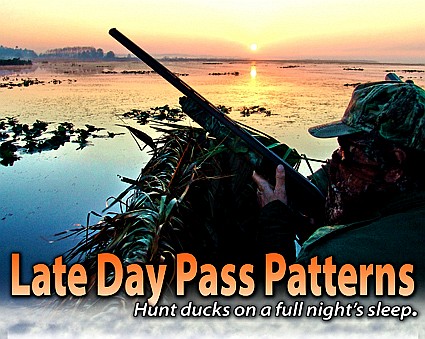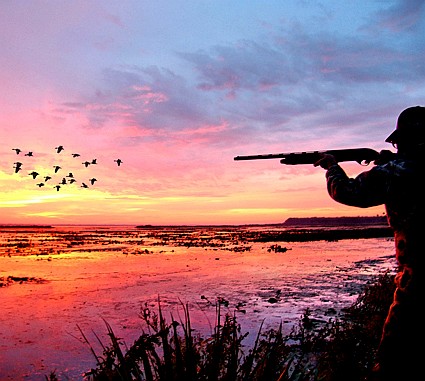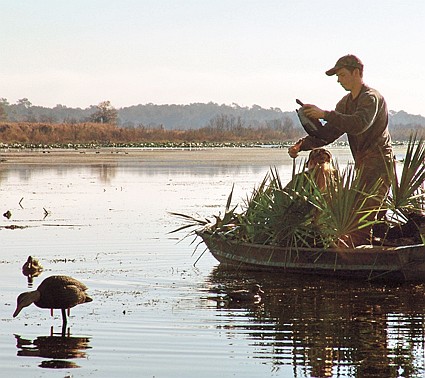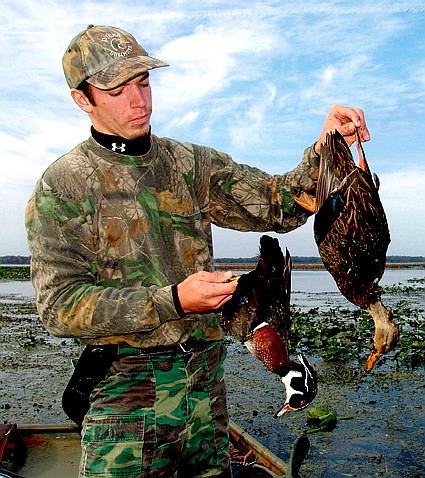November 18, 2015
By Florida Sportsman
 |
By David Dunaway
I knew I was in trouble when I opened my eyes and felt well-rested. No one goes on a serious duck hunt well-rested, do they?
Sure enough, the alarm clock had failed me. First light would be cracking in less than an hour. Fortunately, I didn't have far to go, but when I reached the boat launch on the west shore of Orange Lake, sunrise was a mere 15 minutes away. The parking lot was full of trailers and none of them were dripping water.
My plan had been to hunt wary mid-season birds over a large decoy spread, then check on a flock of black-bellied whistling ducks I'd been watching for a friend, who wanted one to mount. Now, however, it was obvious that setting out even a few decoys would eat up too much precious early flight time. Still, I hoped to get a shot or two at teal passing between two potholes, one of which I had originally planned to hunt. I hid the boat in a small grass tussock that intersected the flight path and climbed out on the tussock with my gun and a five-gallon seat that held a box of shells and my camera.
As a fabulous sunrise unfolded I felt foolish for nearly calling off the hunt just because there had not been time enough to deploy decoys. Bagging birds is not the only aspect of the sport that is appealing. Within moments I made a great shot on a silhouetted anhinga with the camera, then jerked my head in response to peripheral movement in time to see a green-wing drake rapidly exit gunshot range. I had the correct equipment in hand when the next duck, a blue-wing hen, presented a perfect shot and tumbled down almost in my lap. It took only a teal and an anhinga to turn my bleak outlook into a sunny one. I already had some nice pictures and one more duck than my decoy-dependent personality had expected. Once again life was grand.
 |
I'd done a miserable job of shooting the day before and I can't say for certain that the extra sleep was helping me out, but I'm sure it hadn't hurt any because I was about as hot that morning as I ever get. I spotted a group of four teal coming head on, my favorite shot, and just like one I had the day before when I sliced the sky three times with No. 6 steel without ruffling a feather. This morning two of the teal hit the water with a satisfying double splat.
For most waterfowlers the hunt begins well before the day does. In fact, if all turns out as planned, much of it will have taken place in pitch dark and by about sunrise-thirty the most accurate and experienced hunters will be picking up decoys and heading home with limit bags. Their great success may be attributed to the cleverly crafted pop-up blind, or the experienced sweet-talker on a Suzie call, or the picture-perfect placement of decoys. All these points will be hashed over, but in the end it is often the decoys that get the credit for making shy birds put on the brakes in the designated landing zone. Because, after all, decoys are a requirement for duck hunting. Or are they?
After hunting a given area for a time it doesn't take long to recognize regular paths that ducks take, either when flying into feeding areas in the morning or moving from one feeding area to the next. Then, later in the day they may leave feeding areas to loaf in open water rafts. These lanes typically follow distinct features of the water's edge or patches of vegetation farther out in open water. A good pair of binoculars can play an important role in discovering the more heavily traveled routes as will the dreaded trial and error.
 |
Some flyways lend themselves to easy ambush by providing thick vegetation in which to hide a boat, but often, crafty late-season birds make a point of avoiding heavy vegetation from which loud bangs seem to emanate. These late-season paths are more likely to cross, or run alongside, areas of only sparse vegetation. That's when specialized equipment can make a big difference. Hunters who position themselves in such an area in a small, easily concealable boat blind (such as a layout boat) or don waders to take a low profile position there, are likely to have some consistent shooting.
After downing the fifth duck of the bag of six, my thoughts drifted back to years before and I realized I'd come full circle in my love affair with waterfowl. The first hunt on this lake decades earlier was a pass shoot just as this was, but I didn't know it at the time.
Shortly after migrating to the Gainesville area in the early ‘80s, we visited in-laws who lived on land bordering Orange Lake. When uncle Rob Polk asked if I wanted to shoot some ducks, I couldn't think of anything I'd rather do. In preparation we made a short trek into a fallow farm field where we broke off bundles of dog fennel and dragged them to a 14-foot fiberglass boat at the lake's edge. After the cover was loaded I was told to meet him there an hour before daylight the next day.
When I climbed into the boat that morning, I took note of the absence of what I had always thought was a required element of a duck hunt: decoys. Recalling the duck hunts I'd been on as a child with my father, the presence of plastic fakes floating in front of the blinds stood out. The boat did not look like it would make a very good hide, either. It was green but not camo like a “real” duck boat. It did have a line of holes drilled in the gunnels at regular intervals to hold the stems of the fennel bunches which would break up our profiles. I was skeptical yet still had enough young brain cells firing to realize Rob was the expert here. After all, he'd spent most of his life on and made much of his living commercial fishing this lake.
A short run led us to a stand of sparse peppergrass (maidencane), which is not exactly a preferred place to hide a boat, although it is nearly the same color as dried fennel. Just after the last of the fennels were set in place, the rushing sound of wings drew an instant surge of adrenaline that I believe was responsible for my lifetime obsession with the pursuit of waterfowl. Before I'd actually seen a bird among the blurred streaks whizzing past, Rob had put two on the water with his battered 16-gauge pump. I finally spotted and downed a “bullhead” (as Rob and other old-timers called ring-neck ducks) that had passed on my left. Soon after, a pair made a suicide run and we each tumbled one. By sunrise we had our limit and were headed back to a hot breakfast.

Wood duck, left, and mottled duck. |
Limits were lower then, yet on the return run I recall passing a couple of decoy spreads that apparently hadn't tolled in enough to call it a day yet. Rob knew where the birds favored when they flew along the east shore of the lake and had merely set us smack in the middle of that traffic. Decoys might have slowed ‘em down a bit but we did fine without them and it was a simple, no-fuss hunt.
As creatures of habit it is tough enough to change the way we do anything (especially at my age). The pursuit of waterfowl is already so inexact that a new strategy can throw a monkey wrench into patterns ingrained over many years of acceptable success. But as more and more seasons pass, the prospect of sleeping during the time I used to allot for setting out decoys, and eating breakfast when I'd previously still been bagging up the darned things, makes all the more sense to me.
Still one bird shy I decided to cross the lake and see if I could get photos of flushing the black-bellies. Most ducks when holding hard to a feeding or otherwise preferred area will return within 30 to 45 minutes of being flushed, making them vulnerable to ambush if you intersect their return path and are well-hidden. I've found that black-bellies are even more forgiving, providing they have not been pestered much. They will circle the spot long enough to get a few noiseless shots with the camera and still be in range when the camera is exchanged for a gun. If they are heavily pressured, such as with opening day barrages, they will amble off early but religiously return by 9 or 10 a.m. I was so engrossed in the great photo opportunities offered that the birds were nearly out of range, but still circling, when I finally shouldered the gun and dropped one with the second shot.
Heading back to the landing earlier than on most days of hunting over decoys felt great. Having bagged a limit and enjoyed hunting two areas made it all the more sweet. I believe my tendency to usually pass on pass shooting had been for two common reasons. Perhaps the strongest was merely force of habit. The other was wanting to avoid the possible stigma attached to it, which is caused by a minority of pass shooters who target out-of-range ducks.
By putting into play the right tactics on more pass hunts later that season I realized it wasn't very difficult to consistently intercept plenty of in-range birds once familiar with their habits. And while I'm not exactly ready to offer my decoys on eBay, I think I'll be sleeping more when other hunters are fighting with tangled decoys and will still be getting many days of good shooting.
Florida Waterfowling Gains National Attention
By Terry Gibson
There's an amazing if not unparalleled variety of ducks in Florida. Their plumage is bright and full by the time they get here, and wetlands restoration and management programs are state of the art. Filming an episode of “Benelli on Assignment” here in the Sunshine State was thus an easy choice for host Joe Coogan, a Cocoa Beach native.
Advertisement

Joe Coogan. |
I had the chance to join Coogan, today a well-traveled outdoor writer, television host and former magazine editor, on a trip to T.M. Goodwin Waterfowl Management Area near Fellsmere. Goodwin is a special place. Thanks to a partnership among Ducks Unlimited, the St. Johns River Water Management District and the Florida Fish and Wildlife Conservation Commission (FWC), old farmland has been converted into wetlands managed for waterfowl. The area draws an inordinate number of pintails, and Coogan has a passion for shooting mature sprigs.
Scouting the evening before the hunt, we saw rafts of teal and ringbills. Fulvous and black-bellied whistling ducks (a relatively new species to Florida) milled about. We also saw a few flights of widgeon, but the flights of pintails kept Coogan awake that night anticipating the next morning's hunt.
We awoke to ideal duck hunting weather—air temps in the 50s, overcast skies and a stiff breeze. Goodwin manager Steve Rockwood and biologist Mike McMunigal joined us. We used a canoe to cross the canals and carry our gear. When we found a sufficient cover looking out across two open ponds in the marsh, we set out clusters of teal pretty tight, and pairs of mallards and pintails farther from the makeshift blind.
Minutes after legal shooting time, Coogan and Rockwood whistled in a lone drake which circled the decoys three times. Finally, it swung high over my right shoulder, and I was pretty sure the bird had made us. I swung the little Benelli 20-gauge Cordoba autoloader and the bird dropped like a stone.
Between flights, we debated the merits of the 12-gauge Super Black Eagle II models they were shooting versus the 20-gauge I'd opted for. Joe had offered me a 12 gauge, but I rarely resort to those cannons in Florida, and recommend a well-fitting 20 gauge as a starter gun for kids, lady hunters or slight, agile adult hunters like me. Modern non-toxic shot such as Federal's 20-gauge Ultra-Shok High Density No. 4 loads I was shooting have tremendous knockdown power. Florida birds don't have heavy down, and generally decoy pretty well, so you rarely need 60 yards of range.
Joe, Mike and Steve are very disciplined shooters, and the shell-to-knockdown ratio was pretty strong. With a minimum of four ducks apiece, bag limits full or close to full that included widgeon, pintails, ringbills, green- and blue-wing teal and Florida mottled ducks, we decided to quit while we were ahead.
The check-in station was a happy scene. Most hunters filled or came close to filling their limit, including three father/son teams and a father/daughter combo. Species included blue-wing teal, green-wing teal, pintail, widgeon, fulvous whistling ducks, black-bellied whistling ducks, ringbills, bluebills, a hooded merganser, gadwall and Florida mottled ducks. The plumage on the January drakes was nothing short of spectacular.

Blue-wing teal speculum. |
“You know, Terry, there aren't many places in the world where you'll find that diversity,” Coogan said.
First Published Florida Sportsman December 2008
